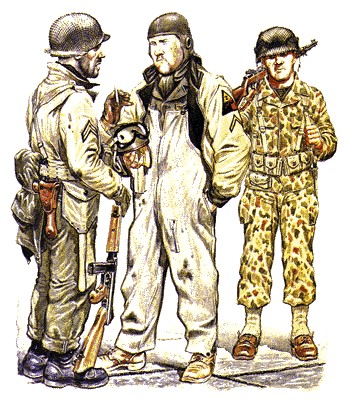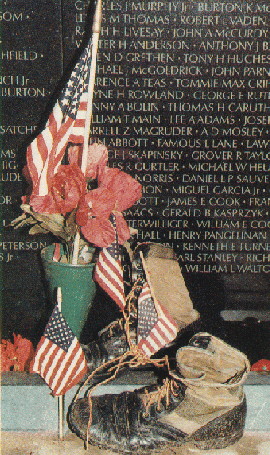 |
82nd Recon History
When the 2nd Armored Division
was activated at Fort Benning on 15 July 1940, less than a month after
the fall of France. The 2nd Armored Division was one of the two original
armored divisions formed by the United States Army. The division was
placed under the command of Brigadier General George S. Scott Jr.,
General George S. Patton Jr. relieved General Scott in September 1940.
The original 2nd Armored Division, created as a miniature army built
around a tank brigade, was authorized 754 officers, 69 warrant officers
and 13,795 men. |
The 82nd Armored Reconnaissance Battalion was activated as
a part of the Second Armored Division, 15 July 1940, at Ft. Benning, Georgia. It
was at that time called the 2nd Reconnaissance Battalion. The skeleton
organization was made up of trained key personnel drawn from cavalry and
reconnaissance units located throughout the United States. On 24 July 1940, the
first cadre, consisting of 89 men, arrived from the 1st Reconnaissance
Battalion, Fort Knox, Kentucky, a similar organization formed a few days
previously from the 7th Cavalry Brigade. Eight men came from the 2nd Squadron,
3rd Cavalry, at Fort. Meyer, Va., and eight from the 1st Squadron, 3rd Cavalry,
at Fort Allen, Vt.
The 3rd Cavalry Regiment began its famous career in 1846,
when it was formed as a " Regiment of the Mounted Riflemen". Through
many campaigns the 3rd Cavalry has lived up to its motto, " Brave Rifles,
Veterans, you have been baptized in fire and blood and come out steel"...
the immortal words of General Winfield Scott after the battle of Chapaultepec.
Twenty six men later arrived from the 2nd Cavalry at Fort Riley, Kansas. The
2nd, was one of the oldest cavalry in the United States Army, has a long and
brilliant record dating back to 1836, when it was formed by an act of Congress
as the 2nd Dragoons. Twenty-three men whose parent organization was the 11th
Cavalry Regiment completed the cadre on 11 August 1901. The 11th Cavalry, formed
at Fort Meyer, Virginia, distinguished itself in the Spanish-American war, and
in General Pershing's punitive expedition against Mexico in 1914.
Proud of its distinguished lineage, the 82nd Armored
Reconnaissance Battalion, the "eyes and ears" of the Second Armored
Division, has already added new battle honors to those handed down to it by its
parent units.
The 2nd Reconnaissance Battalion, formed
from a cadre supplied by the 1st, 2nd, 3rd, 11th, 13th, and 14th Cavalry
Regiments, was activated as an organic unit. Its first commanding officer was
Major, later Major General) Isaac D. White, who as a brigadier general,
commanded the division from 19 January 1945 to 8 June 1945. ( more on Gen. White
in the Generals section) When the division was reorganized on 8 January 1942,
following the Carolina maneuvers, the 2nd was redesignated the 82nd Armored
Reconnaissance Battalion. During those maneuvers the battalion made national
headlines by its first notable feat of arms-the capture of Lt. General Hugh A.
Drum, CG of the First Army. An interesting point, most all of the generals to
command the 2nd Armored Division were from the New England States.
Three platoons of the 82nd were a part of
the initial landing force which forced the capitulation of French North Africa.
On 8 November 1942, one platoon of Co. "C" landed at Safi, with Combat
Command "B" another platoon landed at Fedala, near Casablanca, with
the 9th Infantry Division and a third landed at Mahdia Plage, near Port Lyautey,
with the 3rd Infantry Division.
The 82nd Armored Reconnaissance Battalion
landed at Gela, Sicily on 11th July 1943. The battalion took a major part in the
capture of Butera and the tank company participated in the battle of Mazzarino.
The battalion reconnoitered in front of the division during the advance on
Palermo, brushing aside the enemy road blocks at San Guisseppe Pass. On 22 July
the attack on Palermo began with elements of the battalion covering the
division's flank. After the capture of Palermo, the 82nd was a part of the
Palermo Military District administering prisoners of war.
On 9 June 1944, reinforced by Co.
"D" of the 17th Armored Engineer Battalion, the battalion landed on
Omaha Beach in Normandy as a part of Combat Command "A". During the
St. Lo breakthrough in July 1944 the battalion was attached to Combat Command
"B" and performed in an outstanding manner, pushing rapidly across
Cherbourg peninsula to secure crossings over the Seine river. The
82nd with a tank company of the 67th Armored Regiment attached, took Domfront
during the last part of the division's action against the German counterattack
in the vicinity of Mortain, France. Company "A", 2nd
Platoon, 82nd Reconnaissance closed the gap in the Ardennes
to link the Ninth U.S. Army with the 11th Armored, from the 3rd
U.S. Army.at 0900A, 16 Jan 1944 near Houffalize
After engaging in numerous
actions in the pursuit, on 2
September 1944, patrols of the 82nd crossed into Belgium near Tournai, 12 hours
before any other American troops crossed the frontier.

In and round Hasselt,
Belgium we refer you to Willy Alenus on the "Notables
Generals & Others" page. His article tells the experience
from someone that was there, also is a native of this area of
Belgium.( in the early Sept 44 time frame ). After mopping
up actions with Combat Command "A" in the vicinity of Maastricht,
Holland the battalion defended the left of the bridgehead over the Maas River,
near Sittard, Holland to enable Combat Command "B" to concentrate for
the attack on the Siegfried line.
The battalion took part in the penetration
of the Siegfried line and Co. "D" was the nucleus of a task force
operating on the Combat Command "B" left flank during the operations
against Gereonsweiler.
During the first phase of the "Battle
of the Bulge" (Ardennes Offensive) in Belgium, the 82nd Reconnaissance
Battalion, less one company and two platoons, was attached to Combat Command
"A". One company of the battalion was with Combat Command
"B". In the second phase of the battle in the Ardennes, the battalion
was attached to Combat Command "A" and made contact with the Third
Army sealing the "Bulge" near Houffalize.
During the drive from the Roer River to
the Rhine, the battalion protected the division left flank, maintaining contact
with the 29th Infantry Division on the left.
For operations from 3 April 1945 through
17 April 1945 during the sweep from the Rhine to the Elbe, the 82nd
Reconnaissance Battalion received the Presidential Unit Citation. The operation
consisted of slashing through the enemy's defenses for more than 250 miles,
always far in advance of the main elements of the spearhead force. The advance
was climaxed by a spectacular dash of 62 miles from Gross Manner to the Elbe
River south of Magdeburg in eight hours.
Aggressive movements of the widely
separated companies of the battalion completely disrupted the enemy defenses and
resulted in the killing of 1,000 enemy troops and the capture of 8,943
prisoners, the capture of and the destruction of large quantities of enemy
equipment and the liberation of approximately 32,000 allied prisoners of war
land slave laborers. From 7 May 1945 to 1 January 1946 the 82nd Reconnaissance
Battalion performed occupational roles which included the initial occupation of
Berlin. The battalion sailed from Calais on 21 January 1946 and arrived in Ft.
Hood, Texas on 12 February 1946 where routine training and housekeeping duties
were performed. On 22 November 1946, the battalion was deactivated and zeroed
out thus ending, for a time, a unit which had gained glory and distinction
during its short life.
Battle Honors:
|
 |
Algeria-French Morocco (with
Arrowhead), Sicily (with Arrowhead), Normandy, Northern France, Ardennes Alsace,
Central Europe, Rhineland.
Unit Decorations: Distinguished
Unit Streamer WESTPHALIANPLAINS
Streamer Belgian Croix de Guere
BELGIUM,Streamer Belgian Croix de Guerre, Ardennes, Fourragere in the colors of
Belgian Croix de Guerre.
The 82nd Reconnaissance Battalion was
reactivated on 17 January 1949. The battalion received its cadre from the 66th
& 67th Tank Battalion's and by August was ready for field training. The
battalion successfully completed a tactical training test in December 1949,
following which it acted as aggressor troops against other units of the
division, and again distinguished itself by outstanding display of initiative,
enthusiasm, and aggressiveness by all concerned.
The battalion, with elements of Combat
Command "B", sailed for its new assignment in the European Theatre of
Operations from the port of embarkation at New Orleans, Louisiana , on 4 July
1951, landing at Bremerhaven, Germany, on 17 July 1951. Thus beginning the
second tour of duty for the 82nd Reconnaissance Battalion in Germany.
In a ceremony held
at Ft. Hood, Texas on December 15, 1995, the colors of the 2nd Armored Division
were cased and the colors of the 4th Infantry Division were unfurled over Texas
soil for the first time in history.
[ Up ] [ 82nd Unit Info ]

![]()




